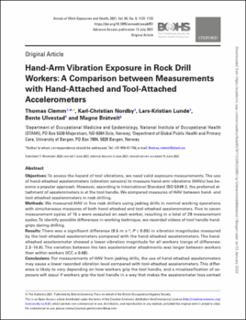| dc.contributor.author | Clemm, Thomas | |
| dc.contributor.author | Nordby, Karl-Christian | |
| dc.contributor.author | Lunde, Lars-Kristian | |
| dc.contributor.author | Ulvestad, Bente | |
| dc.contributor.author | Bråtveit, Magne | |
| dc.date.accessioned | 2022-01-24T13:26:05Z | |
| dc.date.available | 2022-01-24T13:26:05Z | |
| dc.date.created | 2021-08-09T08:50:18Z | |
| dc.date.issued | 2021 | |
| dc.identifier.issn | 2398-7308 | |
| dc.identifier.uri | https://hdl.handle.net/11250/2838981 | |
| dc.description.abstract | Objectives To assess the hazard of tool vibrations, we need valid exposure measurements. The use of hand-attached accelerometers (vibration sensors) to measure hand-arm vibrations (HAVs) has become a popular approach. However, according to International Standard ISO 5349-2, the preferred attachment of accelerometers is at the tool handle. We compared measures of HAV between hand- and tool-attached accelerometers in rock drilling. Methods We measured HAV in five rock drillers using jackleg drills in normal working operations with simultaneous measures of both hand-attached and tool-attached accelerometers. Five to seven measurement cycles of 15 s were executed on each worker, resulting in a total of 29 measurement cycles. To identify possible differences in working technique, we recorded videos of tool handle handgrips during drilling. Results There was a significant difference (9.5 m s−2; P ≤ 0.05) in vibration magnitudes measured by the tool-attached accelerometers compared with the hand-attached accelerometers. The hand-attached accelerometer showed a lower vibration magnitude for all workers (range of difference: 2.3–14.6). The variation between the two accelerometer attachments was larger between workers than within workers (ICC = 0.68). Conclusions For measurements of HAV from jackleg drills, the use of hand-attached accelerometers may cause a lower recorded vibration level compared with tool-attached accelerometers. This difference is likely to vary depending on how workers grip the tool handle, and a misclassification of exposure will occur if workers grip the tool handle in a way that makes the accelerometer lose contact with the vibrating surface. Individual differences in how workers grip the tool handles should be considered when assessing HAV. | en_US |
| dc.language.iso | eng | en_US |
| dc.publisher | Oxford University Press | en_US |
| dc.rights | Navngivelse-Ikkekommersiell 4.0 Internasjonal | * |
| dc.rights.uri | http://creativecommons.org/licenses/by-nc/4.0/deed.no | * |
| dc.title | Hand-arm vibration exposure in rock drill workers. A comparison between measurements with hand-attached and tool-attached accelerometers | en_US |
| dc.type | Journal article | en_US |
| dc.type | Peer reviewed | en_US |
| dc.description.version | publishedVersion | en_US |
| dc.rights.holder | Copyright 2021 The Author(s) | en_US |
| cristin.ispublished | true | |
| cristin.fulltext | original | |
| cristin.qualitycode | 1 | |
| dc.identifier.doi | 10.1093/annweh/wxab051 | |
| dc.identifier.cristin | 1924607 | |
| dc.source.journal | Annals of Work Exposures and Health | en_US |
| dc.source.pagenumber | 1123-1132 | en_US |
| dc.identifier.citation | Annals of Work Exposures and Health. 2021, 65 (9), 1123-1132. | en_US |
| dc.source.volume | 65 | en_US |
| dc.source.issue | 9 | en_US |

